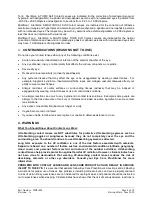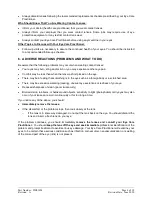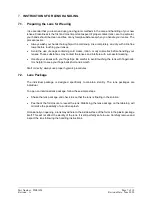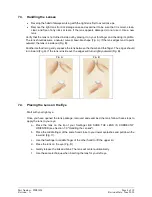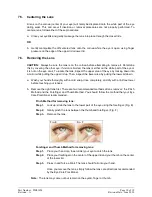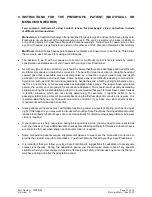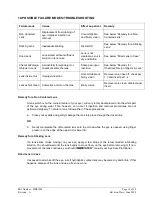
Part Number: PIB01054
Page 13 of 18
Revision: A
Revision Date: June 2020
9. INSTRUCTIONS FOR THE PRESBYOPIC PATIENT (MULTIFOCAL OR
MONOVISION WEARER)
Two common methods of using contact lenses for presbyopic vision correction include
multifocal and monovision.
Monovision:
a treatment technique often prescribed for people age 40 and over who have presbyopia.
Presbyopia occurs as part of the natural aging process. The eye’s crystalline lens loses its ability to
bring close objects into clear focus. Monovision means wearing a contact lens for near vision on one
eye and, if needed, a lens for distance vision on the other eye. (Ref: American Optometric Association)
Multifocal
contact lenses
have separate powers for distance and near vision in each lens. This allows
the wearer to use both eyes for seeing at all distances.
•
The decision to be fit with a monovision correction or multifocal contact lenses is made by careful
consideration and discussion of your needs with your Eye Care Practitioner.
•
As with any type of vision correction, you should be aware that there are advantages and tradeoffs with
multifocal or monovision contact lens correction. The benefit of clear near vision in straight ahead and
upward gaze that is available may be accompanied by a reduction in your visual acuity and depth
perception for distance and near tasks. Some patients experience difficulty adapting to monovision.
Symptoms, such as mild blurred vision, dizziness, headaches and a feeling of slight imbalance, may
last for a brief minute or for several weeks as adaptation takes place. The longer these symptoms
persist, the poorer your prognosis for successful adaptation. You should avoid visually demanding
situations during the initial adaptation period. It is recommended that you first wear these contact lenses
in familiar situations, which are not visually demanding. For example, it might be better to be a
passenger rather than a driver of an automobile during the first few days of monovision lens wear. It is
recommended that you only drive with monovision correction if you pass your state drivers license
requirements with monovision correction.
•
Some patients will never be fully comfortable functioning under low levels of lighting, such as driving at
night. If this happens, you may want to discuss with your Eye Care Practitioner having additional contact
lenses prescribed so that both eyes are corrected optimally for distance when sharp distance binocular
vision is required.
•
If you require very sharp near vision during prolonged close work, you may need to wear spectacles
over your lenses or have additional contact lenses prescribed specifically for this task so that both eyes
are corrected for near when sharp near binocular vision is required.
•
Some monovision patients require supplemental glasses to wear over the monovision correction to
provide the clearest vision for critical tasks. You should discuss this with your Eye Care Practitioner.
•
It is important that you follow your Eye Care Practitioner's suggestions for adaptation to presbyopic
contact lens therapy. During the adaptation period you should make careful note of any specific
situation where you feel unable to function effectively and safely, and discuss any concerns that you
may have during and after the adaptation period.




